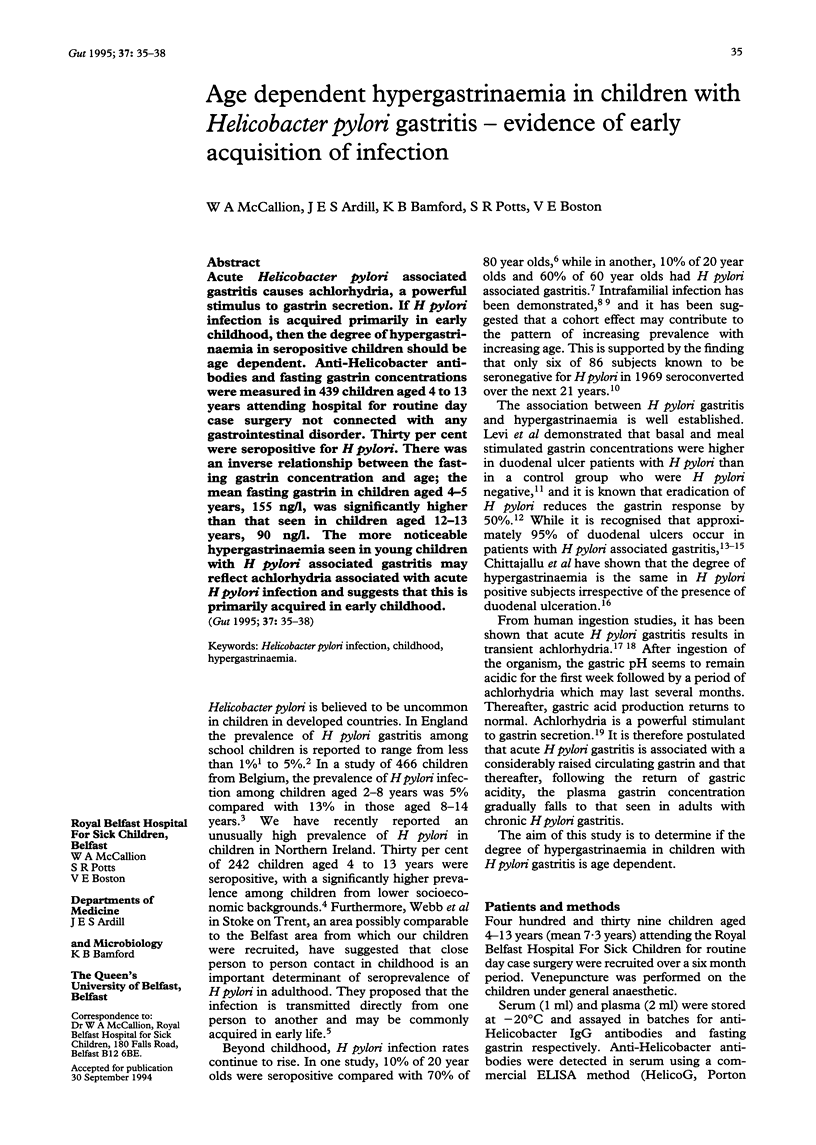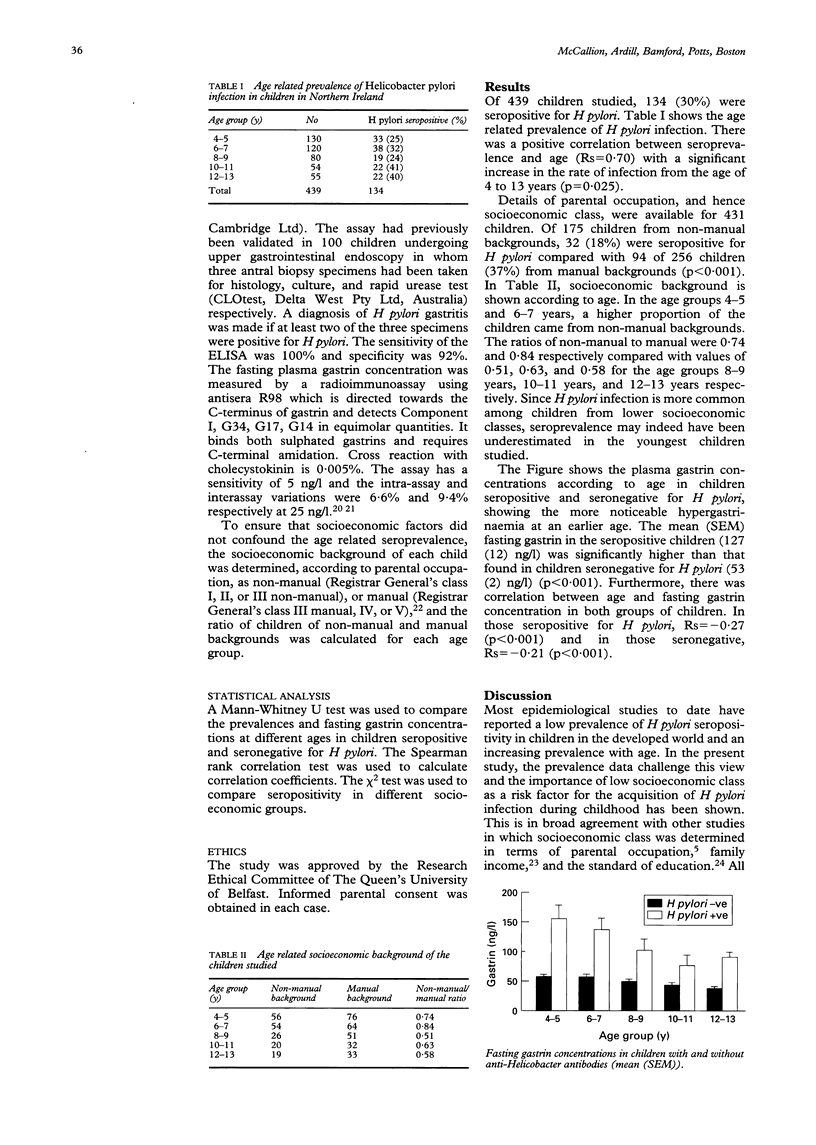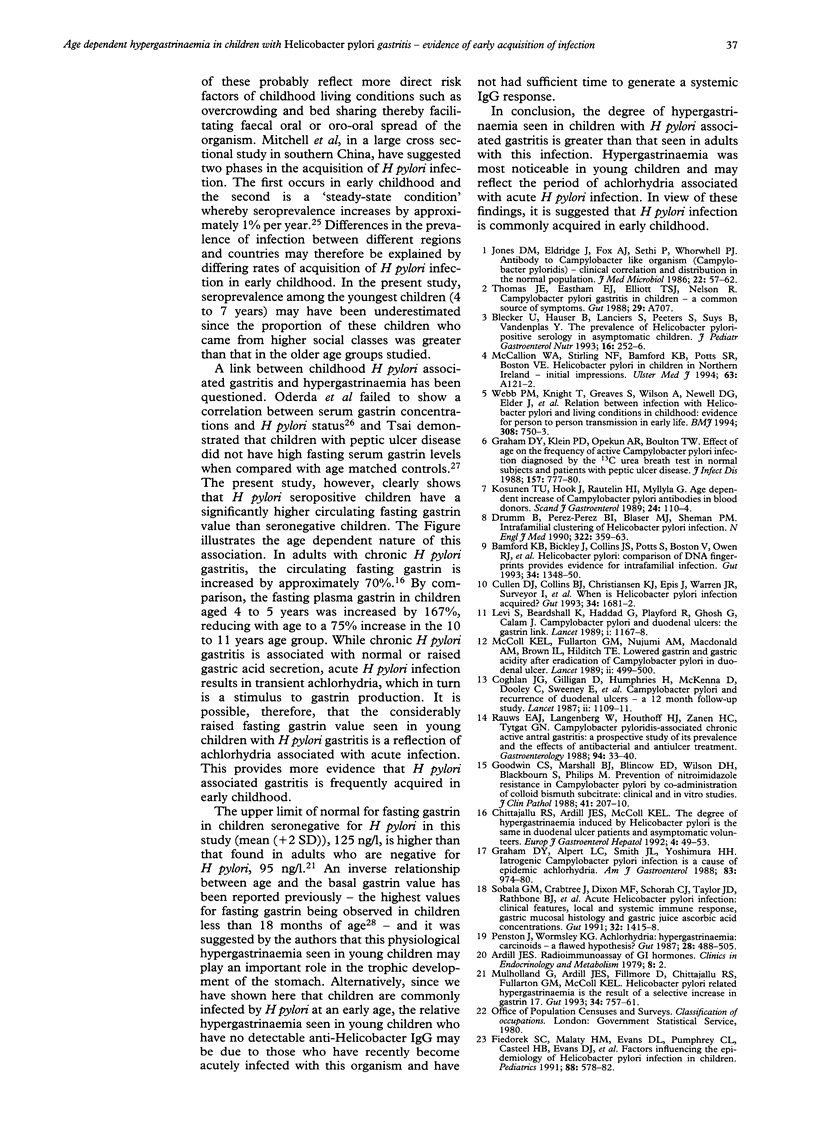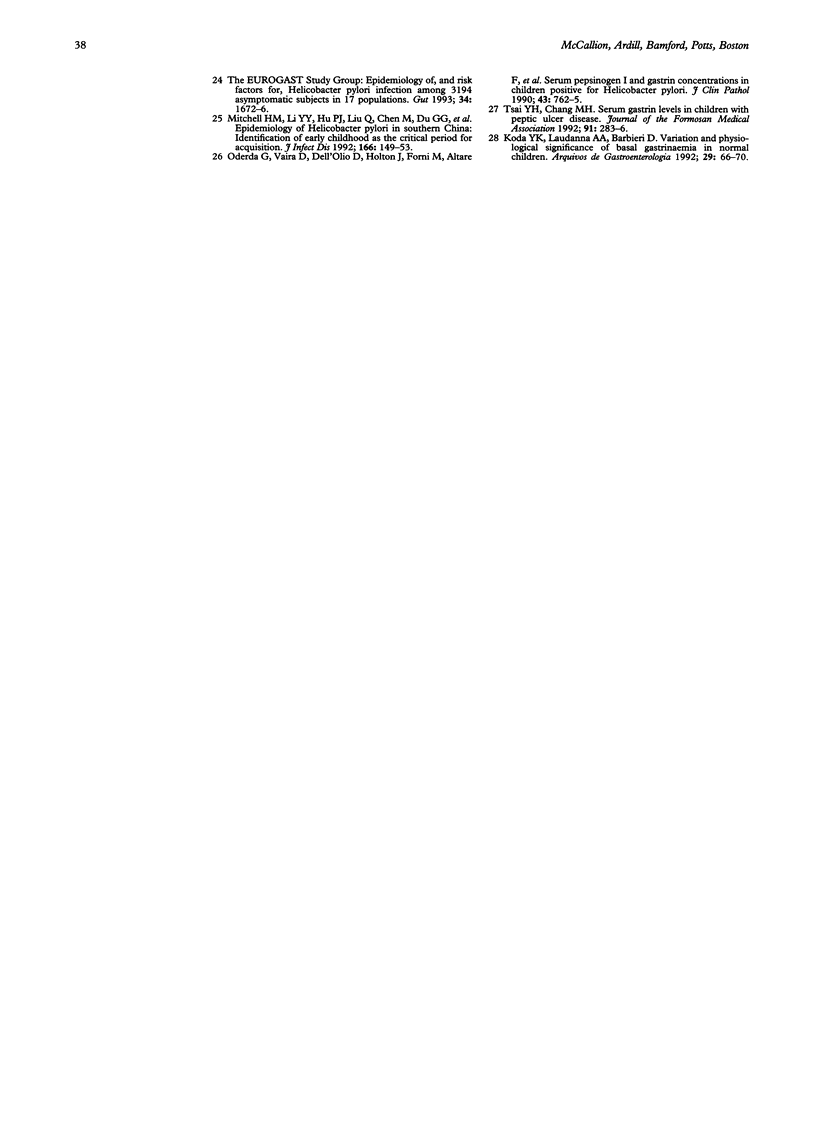Abstract
Acute Helicobacter pylori associated gastritis causes achlorhydria, a powerful stimulus to gastrin secretion. If H pylori infection is acquired primarily in early childhood, then the degree of hypergastrinaemia in seropositive children should be age dependent. Anti-Helicobacter antibodies and fasting gastrin concentrations were measured in 439 children aged 4 to 13 years attending hospital for routine day case surgery not connected with any gastrointestinal disorder. Thirty per cent were seropositive for H pylori. There was an inverse relationship between the fasting gastrin concentration and age; the mean fasting gastrin in children aged 4-5 years, 155 ng/l, was significantly higher than that seen in children aged 12-13 years, 90 ng/l. The more noticeable hypergastrinaemia seen in young children with H pylori associated gastritis may reflect achlorhydria associated with acute H pylori infection and suggests that this is primarily acquired in early childhood.
Full text
PDF



Selected References
These references are in PubMed. This may not be the complete list of references from this article.
- Bamford K. B., Bickley J., Collins J. S., Johnston B. T., Potts S., Boston V., Owen R. J., Sloan J. M. Helicobacter pylori: comparison of DNA fingerprints provides evidence for intrafamilial infection. Gut. 1993 Oct;34(10):1348–1350. doi: 10.1136/gut.34.10.1348. [DOI] [PMC free article] [PubMed] [Google Scholar]
- Blecker U., Hauser B., Lanciers S., Peeters S., Suys B., Vandenplas Y. The prevalence of Helicobacter pylori-positive serology in asymptomatic children. J Pediatr Gastroenterol Nutr. 1993 Apr;16(3):252–256. doi: 10.1097/00005176-199304000-00005. [DOI] [PubMed] [Google Scholar]
- Coghlan J. G., Gilligan D., Humphries H., McKenna D., Dooley C., Sweeney E., Keane C., O'Morain C. Campylobacter pylori and recurrence of duodenal ulcers--a 12-month follow-up study. Lancet. 1987 Nov 14;2(8568):1109–1111. doi: 10.1016/s0140-6736(87)91545-5. [DOI] [PubMed] [Google Scholar]
- Cullen D. J., Collins B. J., Christiansen K. J., Epis J., Warren J. R., Surveyor I., Cullen K. J. When is Helicobacter pylori infection acquired? Gut. 1993 Dec;34(12):1681–1682. doi: 10.1136/gut.34.12.1681. [DOI] [PMC free article] [PubMed] [Google Scholar]
- Drumm B., Perez-Perez G. I., Blaser M. J., Sherman P. M. Intrafamilial clustering of Helicobacter pylori infection. N Engl J Med. 1990 Feb 8;322(6):359–363. doi: 10.1056/NEJM199002083220603. [DOI] [PubMed] [Google Scholar]
- Epidemiology of, and risk factors for, Helicobacter pylori infection among 3194 asymptomatic subjects in 17 populations. The EUROGAST Study Group. Gut. 1993 Dec;34(12):1672–1676. doi: 10.1136/gut.34.12.1672. [DOI] [PMC free article] [PubMed] [Google Scholar]
- Fiedorek S. C., Malaty H. M., Evans D. L., Pumphrey C. L., Casteel H. B., Evans D. J., Jr, Graham D. Y. Factors influencing the epidemiology of Helicobacter pylori infection in children. Pediatrics. 1991 Sep;88(3):578–582. [PubMed] [Google Scholar]
- Goodwin C. S., Marshall B. J., Blincow E. D., Wilson D. H., Blackbourn S., Phillips M. Prevention of nitroimidazole resistance in Campylobacter pylori by coadministration of colloidal bismuth subcitrate: clinical and in vitro studies. J Clin Pathol. 1988 Feb;41(2):207–210. doi: 10.1136/jcp.41.2.207. [DOI] [PMC free article] [PubMed] [Google Scholar]
- Graham D. Y., Alpert L. C., Smith J. L., Yoshimura H. H. Iatrogenic Campylobacter pylori infection is a cause of epidemic achlorhydria. Am J Gastroenterol. 1988 Sep;83(9):974–980. [PubMed] [Google Scholar]
- Graham D. Y., Klein P. D., Opekun A. R., Boutton T. W. Effect of age on the frequency of active Campylobacter pylori infection diagnosed by the [13C]urea breath test in normal subjects and patients with peptic ulcer disease. J Infect Dis. 1988 Apr;157(4):777–780. doi: 10.1093/infdis/157.4.777. [DOI] [PubMed] [Google Scholar]
- Jones D. M., Eldridge J., Fox A. J., Sethi P., Whorwell P. J. Antibody to the gastric campylobacter-like organism ("Campylobacter pyloridis")--clinical correlations and distribution in the normal population. J Med Microbiol. 1986 Aug;22(1):57–62. doi: 10.1099/00222615-22-1-57. [DOI] [PubMed] [Google Scholar]
- Koda Y. K., Laudanna A. A., Barbieri D. Variation and physiological significance of basal gastrinemia in normal children. Arq Gastroenterol. 1992 Apr-Jun;29(2):66–70. [PubMed] [Google Scholar]
- Kosunen T. U., Hök J., Rautelin H. I., Myllylä G. Age-dependent increase of Campylobacter pylori antibodies in blood donors. Scand J Gastroenterol. 1989 Jan;24(1):110–114. doi: 10.3109/00365528909092247. [DOI] [PubMed] [Google Scholar]
- Levi S., Beardshall K., Haddad G., Playford R., Ghosh P., Calam J. Campylobacter pylori and duodenal ulcers: the gastrin link. Lancet. 1989 May 27;1(8648):1167–1168. doi: 10.1016/s0140-6736(89)92752-9. [DOI] [PubMed] [Google Scholar]
- McColl K. E., Fullarton G. M., el Nujumi A. M., Macdonald A. M., Brown I. L., Hilditch T. E. Lowered gastrin and gastric acidity after eradication of Campylobacter pylori in duodenal ulcer. Lancet. 1989 Aug 26;2(8661):499–500. doi: 10.1016/s0140-6736(89)92105-3. [DOI] [PubMed] [Google Scholar]
- Mitchell H. M., Li Y. Y., Hu P. J., Liu Q., Chen M., Du G. G., Wang Z. J., Lee A., Hazell S. L. Epidemiology of Helicobacter pylori in southern China: identification of early childhood as the critical period for acquisition. J Infect Dis. 1992 Jul;166(1):149–153. doi: 10.1093/infdis/166.1.149. [DOI] [PubMed] [Google Scholar]
- Mulholland G., Ardill J. E., Fillmore D., Chittajallu R. S., Fullarton G. M., McColl K. E. Helicobacter pylori related hypergastrinaemia is the result of a selective increase in gastrin 17. Gut. 1993 Jun;34(6):757–761. doi: 10.1136/gut.34.6.757. [DOI] [PMC free article] [PubMed] [Google Scholar]
- Oderda G., Vaira D., Dell'Olio D., Holton J., Forni M., Altare F., Ansaldi N. Serum pepsinogen I and gastrin concentrations in children positive for Helicobacter pylori. J Clin Pathol. 1990 Sep;43(9):762–765. doi: 10.1136/jcp.43.9.762. [DOI] [PMC free article] [PubMed] [Google Scholar]
- Penston J., Wormsley K. G. Achlorhydria: hypergastrinaemia: carcinoids--a flawed hypothesis? Gut. 1987 Apr;28(4):488–505. doi: 10.1136/gut.28.4.488. [DOI] [PMC free article] [PubMed] [Google Scholar]
- Rauws E. A., Langenberg W., Houthoff H. J., Zanen H. C., Tytgat G. N. Campylobacter pyloridis-associated chronic active antral gastritis. A prospective study of its prevalence and the effects of antibacterial and antiulcer treatment. Gastroenterology. 1988 Jan;94(1):33–40. [PubMed] [Google Scholar]
- Sobala G. M., Crabtree J. E., Dixon M. F., Schorah C. J., Taylor J. D., Rathbone B. J., Heatley R. V., Axon A. T. Acute Helicobacter pylori infection: clinical features, local and systemic immune response, gastric mucosal histology, and gastric juice ascorbic acid concentrations. Gut. 1991 Nov;32(11):1415–1418. doi: 10.1136/gut.32.11.1415. [DOI] [PMC free article] [PubMed] [Google Scholar]
- Tsai Y. H., Chang M. H. Serum gastrin levels in children with peptic ulcer disease. J Formos Med Assoc. 1992 Mar;91(3):283–286. [PubMed] [Google Scholar]
- Webb P. M., Knight T., Greaves S., Wilson A., Newell D. G., Elder J., Forman D. Relation between infection with Helicobacter pylori and living conditions in childhood: evidence for person to person transmission in early life. BMJ. 1994 Mar 19;308(6931):750–753. doi: 10.1136/bmj.308.6931.750. [DOI] [PMC free article] [PubMed] [Google Scholar]


